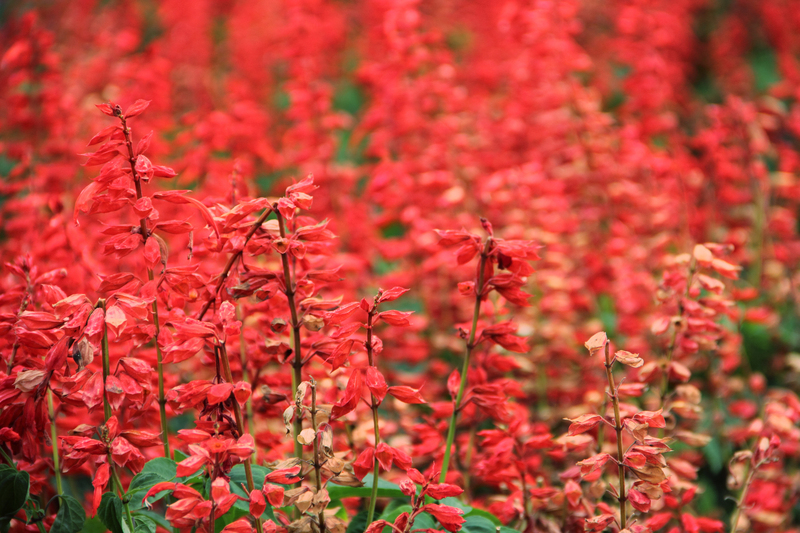Pro Tips for Controlling Weeds: Three Strategies to Implement
Posted on 21/08/2025
Pro Tips for Controlling Weeds: Three Strategies to Implement
Unwanted weeds can quickly take over your garden or lawn, suffocating your prized plants and robbing your soil of nutrients. Understanding the best methods for weeds control can make a significant difference in maintaining a healthy, attractive landscape. In this comprehensive guide, you'll discover expert pro tips for controlling weeds efficiently--whether you're tending to a neat vegetable garden, a lush lawn, or ornamental flower beds. Below, we unveil three proven strategies to implement that will help minimize weed infestations and keep your outdoor oasis thriving all year round.
Why Effective Weed Control Is Crucial
Before diving into weed management strategies, it's important to recognize the impact that weeds can have on your plants and property:
- Competition for resources: Weeds compete for sunlight, water, and nutrients, leading to stunted plant growth.
- Spread of pests and diseases: Weeds may harbor insect pests and pathogens that attack desirable plants.
- Negative aesthetics: A weedy garden or lawn appears neglected, reducing curb appeal and property value.
- Allergenic effects: Some weeds produce pollen that can worsen allergies for people and pets.
Mastering weed prevention techniques is essential for maintaining the health and beauty of any landscape. Let's explore the proven methods used by professionals.

Strategy One: Preventative Weed Control
1.1 The Power of Mulching
Mulching is widely recognized as one of the most effective preventative measures in weed control.
- Suppresses germination: Mulch creates a physical barrier, blocking sunlight and preventing weed seeds from sprouting.
- Retains soil moisture: Mulch helps keep soil moist, which benefits plants but makes weed germination harder.
- Improves soil structure: Organic mulch decomposes, enriching the soil and fostering beneficial microorganisms.
Common mulch options include wood chips, bark, straw, shredded leaves, or grass clippings. Apply a 2-3 inch layer around plants, trees, and vegetable beds, avoiding direct contact with stems to prevent rot. This barrier is not only an eco-friendly weed prevention strategy but also enhances your garden's appearance.
1.2 Choose Quality Landscape Fabric
Landscape fabric is another excellent tool for controlling weeds in flower beds and pathways. It allows air, water, and nutrients through--yet stops weeds from growing upward.
- Select non-woven, permeable fabric for longevity.
- Install fabric beneath mulch for maximum durability.
- Overlap the fabric edges to eliminate gaps and pin it securely in place.
Unlike plastic sheeting, breathable weed barriers are recommended by professionals as they avoid root suffocation and minimize runoff.
1.3 Practice Dense Planting
One simple, natural approach to prevent weeds is to crowd them out:
- Space desirable plants closely to shade the soil.
- Use groundcovers, low-growing perennials, or cover crops to fill bare spots.
- Rotate crops annually in vegetable gardens--another pro tip to keep weed populations low!
By limiting open soil, weeds have less space to establish and compete.
Strategy Two: Manual and Mechanical Weed Removal
2.1 Hand Pulling and Regular Inspection
Hand pulling remains a time-tested, organic weed control tactic. For best results, follow these expert tips:
- Weed after rain or irrigation--the soil is softer, so roots are easier to extract.
- Grasp weeds at the base and pull slowly to remove the whole root system.
- Carry a bucket or bag for collection and disposal to prevent reseeding.
Tip: Regular inspection is key--walk your garden or lawn weekly for new weeds and remove them before they mature and go to seed.
2.2 Choose the Right Tools for the Job
When hand weeding isn't practical, use appropriate mechanical weed control tools to save time and effort:
- Hoes: Ideal for slicing small weeds just beneath the soil surface. Both stirrup and scuffle hoes allow swift motion and minimal soil disruption.
- Weeding knives or diggers: Help extricate taproot weeds like dandelions, thistles, or dock.
- Wheel hoes and cultivators: Effective for large garden beds or paths, disturbing weeds before they root deeply.
Clean tools after each use to reduce the spread of reproductive weed fragments or seeds.
2.3 Mechanical Control Methods: Mowing and String Trimming
For lawns, orchards, or meadows, routine mowing or string trimming stops weeds from blooming and dispersing seeds:
- Keep lawn grass at a recommended height--taller grass outcompetes many common weeds.
- Trim edges, fence lines, and neglected corners frequently.
- Never allow weeds to set seed--timeliness is crucial for effective weed management.
Pro tip: Dispose of clippings from weedy areas to prevent unintentional reseeding when composting.
Strategy Three: Smart Chemical and Integrated Weed Management
While the previous methods focus on organic tactics, sometimes chemical approaches are necessary for persistent or large-scale infestations. The goal is to use herbicides judiciously and always in combination with mechanical and cultural practices--what pros call Integrated Weed Management (IWM).
3.1 Proper Herbicide Application
Consider these pro guidelines for targeted herbicide use:
- Identify the weed species to select the most effective product (broadleaf, grassy, or sedge control, for example).
- Apply only to actively growing weeds and follow label instructions for concentration and timing.
- Spot-treat problem areas instead of blanketing the entire landscape.
- Avoid spraying during windy conditions or drought--this prevents drift and protects desirable plants.
Note: There are both pre-emergent and post-emergent herbicides. Pre-emergent herbicides form a chemical barrier in the soil, blocking new weed seeds from sprouting, while post-emergent products target existing, active weeds.
3.2 Mix and Match Methods for Integrated Weed Management (IWM)
Integrated Weed Management combines preventative, mechanical, and chemical controls for a sustainable, long-term solution. Here's how to implement IWM:
- Monitor your garden or grounds regularly--early identification allows for swift action before weeds spread.
- Rotate control strategies--over-reliance on one method may lead to resistant weed populations.
- Maintain healthy soils and desirable plant cover--vigorously growing crops or plants naturally suppress weed growth.
- Document results and adapt--keep notes from season to season on what strategies work best for your site.
Many professional landscapers and farmers rely on IWM to ensure robust, weed-free environments while minimizing environmental impact.
3.3 Non-Toxic and Eco-Friendly Weed Control Options
Concerned about children, pets, or pollinators? Natural weed killers can be part of your arsenal:
- Boiling water: Pour carefully over target weeds in driveways or cracks.
- Horticultural vinegar: Non-selective and strong; best for hard surfaces, not lawns or flower beds.
- Corn gluten meal: Used as a pre-emergent, it suppresses new weed seeds (primarily in lawns).
- Flame weeders: Propane torches quickly scorch and wilt annual weeds in hardscapes and gravel.
Always test any method on a small area first and use care to avoid damaging wanted plants.
Additional Pro Tips for Sustained Weed Control
- Water wisely: Use drip irrigation or soaker hoses to deliver moisture only to plants' roots, reducing weed-friendly damp areas.
- Stay vigilant year-round: Weed seeds can remain dormant for years--consistent attention is necessary.
- Compost with caution: Don't add mature weed seeds or roots to your compost pile unless it reaches "hot" composting temperatures (140?F+).
- Check new soil and mulch: Sometimes, purchased amendments contain weed seeds. Buy from reputable sources and inspect before use.

Frequently Asked Questions About Weed Control
- What is the best time to manage weeds?
Early spring and after rainfall are ideal, as young weeds are more easily controlled. Monitor weekly during growing seasons. - How can I prevent weeds organically?
Mulching, hand-pulling, dense spacing, and cover cropping are all top organic weed prevention methods. - Is it OK to use landscape fabric under mulch?
Yes, for paths and beds with perennials, landscape fabric and mulch together form an effective long-lasting weed barrier. - Are all weeds bad for my garden?
Not necessarily--some weeds, like clover, can add nitrogen to the soil. However, most compete harmfully with desired plants. - How can I ensure a weed-free lawn?
Mow high, overseed thin spots each fall, fertilize properly, and use pre-emergent treatments if needed.
Conclusion: Create a Weed-Free, Thriving Landscape
Whether you're a home gardener or a landscape professional, these pro tips for controlling weeds--from prevention with mulching and fabric barriers, to timely manual removal, to integrating chemical and non-toxic options--are your secret weapons for keeping weeds at bay. The key to effective weed control is consistency: monitor your beds, adapt your approach with the seasons, and always act before weeds have a chance to mature and spread.
With these weed management strategies in your gardening toolkit, you're well-equipped to enjoy vibrant, healthy, and beautiful outdoor spaces all year long. Happy gardening--and here's to a future of green, weed-free success!

